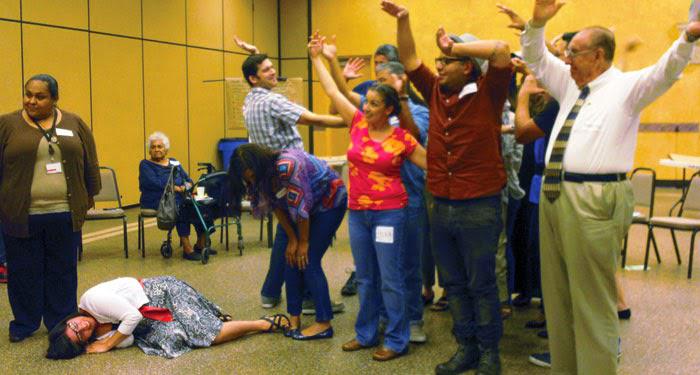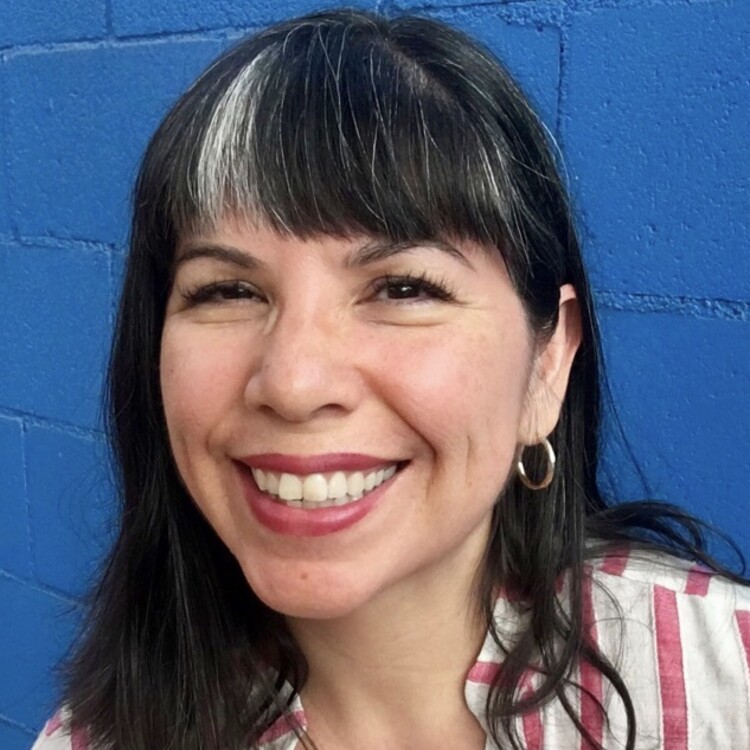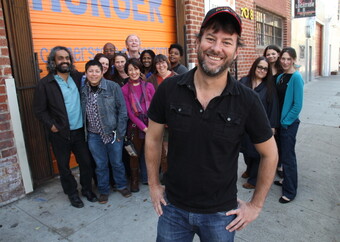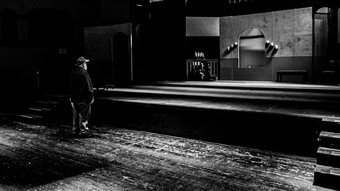A Bridge to End a Social and Economic Divide
Dialogue/Diálogos Project
Growing up in Orange County (Santa Ana, specifically), I’m grateful to my mother for exposing me to arts and culture even when I wasn’t always a willing participant. As a “tween,” a preadolescent youth, I recall being dragged to South Coast Repertory’s (SCR) Hispanic Playwrights Project (HPP).
I say dragged because my mom has a unique gift to turn our every outing into a volunteer experience. My mother enjoys being involved in community, and even as a single parent with a full time job, she found time to give and volunteer. When she started talking “educational,” “entertaining,” “inspiring,” “good for me,” l could only picture myself sorting stuff, signing people in, decorating, assembling something, or maybe picking up trash.
Nevertheless, we headed to SCR with the promise that we were there to only enjoy theater. At the time I thought, “I could be home watching Dynasty,” but once the house lights dimmed and the actors began transforming pages into story, my doubts were silenced. I was captivated, imagining it all in my mind, staging the whole thing. It was through Lisa Loomer’s play The Birds that I was opened to the process of theater making, and from that point forward, I never needed dragging again.
Rare, treasured experiences like these are what led me to study acting and theater in college. I worked as an actor, writer, director, teaching artist, producer, and founding artistic director of Breath of Fire Latina Theater Ensemble in Santa Ana. In 2007, I joined SCR as a conservatory faculty member and in 2012 became the engagement director of SCR’s Dialogue/Diálogos Project.
In our time with the community, we have gathered stories from Santa Ana residents, presented play-making and play development workshops, and participated in countless community activities reaching thousands of people.
SCR’s Dialogue/Diálogos is a two-year bilingual community-based initiative that focuses on creating an original play with and by the Latina/o community of Santa Ana, led by playwright José Cruz González. The program springs from our leadership team—Artistic Director Marc Masterson and Managing Director Paula Tomei.
In our time with the community, we have gathered stories from Santa Ana residents, presented play-making and play development workshops, and participated in countless community activities reaching thousands of people. We are now set to bring back to the Santa Ana community the first draft of a play, The Long Road Today/El Largo Camino Hoy, inspired by their stories. The final play will be site-specific and produced in the Fall of 2014 and is funded by The James Irvine Foundation.

The project and its scale are firsts for SCR, Santa Ana, and Orange County. Overall, Orange County has a racially and ethnically diverse population and SCR has a history serving the community. However, even though Santa Ana borders SCR, they are worlds apart. The percentage of Santa Ana residents who are in connection to the theater and SCR is small.
Santa Ana, incorporated in 1886, is the second largest city of Orange County, the county seat, and the eleventh largest city in California, with the first all Latino city council in the United States. According to the US Census Bureau, 78 percent of the residents of Santa Ana are of Hispanic or Latino origin, and it is the country’s youngest city, with a median age of 29.
The poverty level in Santa Ana is 46.6 percent greater than the California average and 61.4 percent greater than the national average. In 2004 the LA Times wrote that Santa Ana is “…the nation's toughest place to survive.” Even after ten years, this characterization continues to define Santa Ana.
Most Santa Ana residents or Santaneros (a term many use) credit the city to be la ciudad de oro (the golden city) and la corazón (the heart) of the county. Gustavo Arellano of ¡Ask a Mexican!, a popular OC Weekly column, widely syndicated and made into a book of the same title, answers a range of questions about Mexicans and boasts, “...I would say the best city in Orange County is ‘SanTana.’” A term he's coined.
The Santa Ana community shares that same love and a strong sense of self and pride. The residents are filled with dreams and aspirations for their children, families, and neighborhoods. Most are not waiting for things to happen, but are making things happen, often with little to no resources: including advocating for a healthier community, better education, and art-making opportunities. For many participants in Dialogue/Diálogos, this is their first experience with theater, the same way HPP was for me.
The project’s success has been due to a number of factors, including (but not limited to): playwright-in-residence José Cruz González, someone I have looked up to since his time at HPP and CuCuCuevez Teatro at Santa Ana College; early consultation, training, and guidance from Cornerstone Theater Company—a company that combines the artistry of professional and community collaborators in theater; the help and support of an incredible ensemble of individuals and professional teaching artists; and a partnership with Latino Health Access (LHA), a Santa Ana-based health organization celebrating its twentieth anniversary that engages and empowers the community, forges partnerships, and advocates health equity for all.
America Bracho, LHA’s executive director spoke about the partnership with SCR, saying “[I] believe that health is a state of physical, mental, social, and spiritual well-being. We welcome SCR… in this process to [share] the power of performing arts [and] make our communities healthier places.” LHA has been vital to this process. The organization has followed the philosophy of Bracho, “in order to connect with people you must first engage the heart and then train the brain.”
The residents are filled with dreams and aspirations for their children, families, and neighborhoods. Most are not waiting for things to happen, but are making things happen, often with little to no resources.
LHA is a perfect fit and key to our project. Story sharing is already an integral part of the organization. Through story the promotores/community workers are able to relate and connect to the many people that they meet as they go door to door in the community. Many of their programs have been born from needs expressed by the residents who subsequently engage their neighbors and friends. Most of the promotores/community workers are often the people that began as clients.
Since the project’s launch in early 2013, we have had twelve story circles, ten theater-making workshops, four structure sharings, four devising sessions, and now close to five community staged readings hosted at LHA and throughout the community. All this work has been in preparation for the upcoming production, which will run September 19–28, 2014.
At these activities, participant turnouts have been as large as 200-plus. Food and refreshments were often served and daycare made available to those who needed it.
As people shared stories, they also expressed interest in learning more about what we do in theater. We then returned to the community and offered free theater-making workshops ranging from introduction to design, production, acting, movement, singing, voice, puppetry, and storytelling. Our opening workshop drew nearly 250 people and kept a local theater critic engaged for the entire evening. Throughout the process many participants, ranging from everyday people, local artists, the Diálogos ensemble and interns, executive and artistic staff, and others have joined the conversation to offer thoughts, concerns, questions, and interpretations. These collective perspectives have allowed us greater insight and to tailor the needs of the project. Working collaboratively has been our strength and has helped us address and discover what will best serve to tell the story of Santa Ana.
Participants have shared their experiences, like frequent participant Maria Elena: “I am loving and enjoying [Diálogos]... I am putting a lot of concepts into practice in my relationships, work, and life in general. I have been learning how to communicate more efficiently, how to accept and love myself and embrace the gifts that I have. It has brought out the loud, dramatic, playful Maria Elena hidden inside my shell.” This process is affecting not only participants but also leaders in the ensemble.
Moisés Vázquez is an LHA liaison and his function is to be just that. He began at LHA as a reluctant teen who didn’t have much to do after school and became a musician in the community. The many stories that we’ve collected have led Vázquez to compose some of the most uplifting, haunting, and moving pieces for the play. His powerful connection to the community and music has led him to this work.
This spring, Diálogos continues with a series of four staged readings throughout the city hosted by additional project partners, including: Santa Ana College, The Bowers Museum, Orange County School of the Arts, and KidWorks. The readers are ongoing participants, students, and staff of host and surrounding institutes and schools. We look forward to sharing the play and hearing the feedback to help us better prepare for our production in September.
Heading this project and bringing together the world of theater and this community has been a great challenge and an incredible blessing. I love, admire, and advocate for both. The project has the potential to build bridges between SCR and the SanTana community that is rooted in its culture, language, and identity by creating stories to be shared and allowing neighbors to be neighborly. And as Angela, a Diálogos participant, shares, “My community of Santa Ana is so unique and full of vitality, how could I walk by without stopping to hear its stories?”
When all is said and done, what this project may leave with us all I can only imagine. HPP existed for nearly twenty years and in that time I, like many others, have found my place in theater and can only anticipate what the impact of Diálogos may have on the next generation.











Comments
The article is just the start of the conversation—we want to know what you think about this subject, too! HowlRound is a space for knowledge-sharing, and we welcome spirited, thoughtful, and on-topic dialogue. Find our full comments policy here
Thank you for your wonderful thoughts, Jesus. It's also really exciting to hear what you are doing through CTG's The Shop Project in Boyle Heights. I appreciate how your project is exploring the question: "How can we make the art of theatre integral to people’s daily lives?" That's a question I ask myself everyday and I hope that through our projects we not only invite this curiosity but also establish long term relationships that can continue to build this work and opportunities. Thank you, again! Abrazos!
SCR has been a leader on many fronts. SCR has championed new work and was a leader of Latina/o
playwrights. SCR is again a leader in working with community on a large scale. It is without a doubt that much has to shift and change within a large mainstream institution, and to continue community work SCR has to adapt and re-focus internally to take up the charge of community work alongside its
mainstream offerings. As a leader, SCR, with this program, has partnered with many other leaders that have been doing community based work even before "creative placemaking" was coined. At this juncture, SCR has significant leadership in place with Sara Guerrero, Kimberly Colburn, Jose Cruz
Gonzalez and Moises Vazquez and all the people that are contributing to this exciting project in the community and in the building. I salute SCR and hope they will continue leading beyond this project.